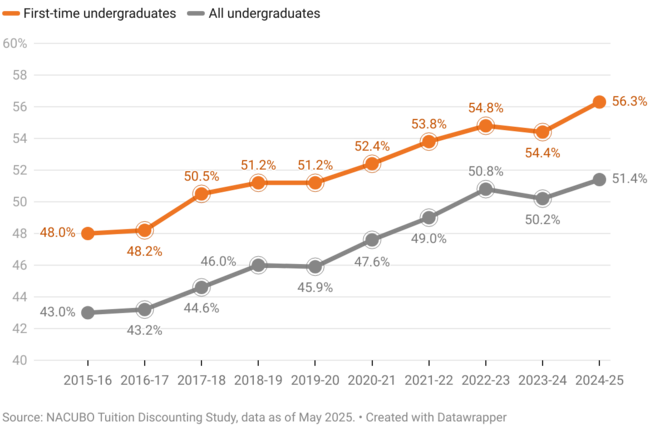You have /5 articles left.
Sign up for a free account or log in.

NACUBO Report
Tuition discounting rates have once again hit an all-time high.
The average discount rate in the 2024–25 academic year was 56.3 percent for first-time, full-time undergraduates at private colleges and 51.4 percent for all undergraduates, according to an annual study commissioned by the National Association of College and University Business Officers. That means that for every dollar of undergraduate tuition, private nonprofit colleges kicked in 56 cents in grant aid for first-time undergraduates and 51 cents to all undergraduates who received institutional grant aid.
The rate for first-time, full-time undergraduates ticked up two percentage points compared to the 2023–24 academic year, while the rate for all undergraduates increased by about one percentage point. In all, 286 private nonprofit institutions participated in the NACUBO Tuition Discounting Study.
As the study noted, discounting strategies are often “used to attract or retain students who are unable or unwilling to pay” full tuition and fees, or what is commonly known as “sticker price.” Although lawmakers and others point to the sticker price as a reflection of the cost of college, the practice of tuition discounting muddies the waters and makes it difficult to know what students are actually paying. The study focused only on private nonprofit institutions, explaining, “Public institutions also award institutional grants. However, private nonprofit institutions and public colleges and universities are built on fundamentally different revenue models, so their discounting practices cannot be compared fairly.”
More than 83 percent of students received some institutional grant aid, according to NACUBO. Among first-time, full-time undergraduates, that number was just under 90 percent.
“The NACUBO Tuition Discounting Study underscores an important kitchen-table issue: Although some families may assume that college is out of reach, there are many, many private colleges and universities across the country that offer substantial financial aid to bring down the cost of a postsecondary education,” NACUBO president and CEO Kara D. Freeman said in a news release about the study findings. “We urge students, parents, and policymakers to consider these findings and the effort these institutions are making to remain affordable to all students.”
The study also found that enrollment was mostly flat at participating institutions. Asked how they plan to increase admissions, enrollment and retention, the most common answer from study participants was to adopt new financial aid strategies, which 54.2 percent said they intend to do. After that came new retention efforts at 52.7 percent.
Colleges that reported enrollment declines cited a number of factors. But the top reason, by far, was delays due to issues processing financial aid related to the botched rollout of the Free Application for Federal Student Aid, which 77.1 percent of colleges blamed.
“Responses indicate that the pool of potential students, shifts in market demands, and price sensitivity are important drivers behind declining undergraduate enrollment,” authors noted.
Net tuition revenue rose by 1.4 percent over the last academic year when adjusted for inflation.
Authors wrote in the study that data collection “occurred prior to the Trump administration’s actions related to changes in federal grants and contracts to higher education institutions and changes in policies related to foreign students.” Those changes, which include capping research reimbursement rates and clamping down on international student enrollment, are therefore not reflected in this year’s study, though authors noted plans to examine those effects in the future.
Additionally, authors noted that data collected for the 2024–25 academic year are preliminary estimates and will likely change in the Tuition Discount Study that will be published next year because of the changing nature of participating institutions year to year and because colleges “complete the survey in the fall before enrollments and aid packages are finalized in the spring.”




